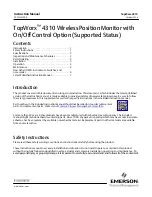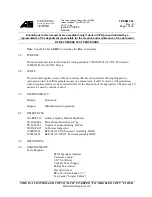
Instruction Manual
D103622X0KR
TopWorx 4310
October 2016
3
Installation
WARNING
Avoid personal injury or property damage from sudden release of process pressure or bursting of parts. Before mounting
the product:
D
Do not install any system component where service conditions could exceed the limits given in this manual or the limits
on the appropriate nameplates. Use pressure‐relieving devices as required by government or accepted industry codes
and good engineering practices.
D
Always wear protective gloves, clothing, and eyewear when performing any installation operations.
D
Do not remove the actuator from the valve while the valve is still pressurized.
D
Disconnect any operating lines providing air pressure, electric power, or a control signal to the actuator. Be sure the
actuator cannot suddenly open or close the valve.
D
Use bypass valves or completely shut off the process to isolate the valve from process pressure. Relieve process pressure
from both sides of the valve.
D
Vent the pneumatic actuator loading pressure and relieve any actuator spring precompression so the actuator is not
applying force to the valve stem; this will allow for the safe removal of the stem connector.
D
Use lock‐out procedures to be sure that the above measures stay in effect while you work on the equipment.
D
The valve packing box might contain process fluids that are pressurized,
even when the valve has been removed from the
pipeline.
Process fluids might spray out under pressure when removing the packing hardware or packing rings, or when
loosening the packing box pipe plug. Cautiously remove parts so that fluid escapes slowly and safely.
D
The instrument is capable of supplying full supply pressure to connected equipment. To avoid personal injury and
equipment damage, caused by sudden release of process pressure or bursting of parts, make sure the supply pressure
never exceeds the maximum safe working pressure of any connected equipment.
D
Severe personal injury or property damage may occur from an uncontrolled process if the instrument air supply is not
clean, dry and oil‐free, or noncorrosive gas. While use and regular maintenance of a filter that removes particles larger
than 40 microns will suffice in most applications, check with an Emerson Process Management field office and Industry
Instrument air quality standards for use with corrosive gas or if you are unsure about the proper amount or method of
air filtration or filter maintenance.
D
For corrosive media, make sure the tubing and instrument components that contact the corrosive media are of suitable
corrosiion-resistant material. The use of unsuitable materials might result in personal injury or property damage due to
the uncontrolled release of the corrosive media.
D
If natural gas or other flammable or hazardous gas is to be used as the supply pressure medium and preventive
measures are not taken, personal injury and property damage could result from fire or explosion of accumulated gas or
from contact with hazardous gas. Preventive measures may include, but are not limited to: Remote venting of the unit,
re‐evaluating the hazardous area classification, ensuring adequate ventilation, and the removal of any ignition sources.
D
To avoid personal injury or property damage resulting from the sudden release of process pressure, use a high‐pressure
regulator system when operating the controller or transmitter from a high‐pressure source.
The instrument or instrument/actuator assembly does not form a gas‐tight seal, and when the assembly is in an
enclosed area, a remote vent line, adequate ventilation, and necessary safety measures should be used. Vent line piping
should comply with local and regional codes and should be as short as possible with adequate inside diameter and few
bends to reduce case pressure buildup. However, a remote vent pipe alone cannot be relied upon to remove all
hazardous gas, and leaks may still occur.
D
Personal injury or property damage can result from the discharge of static electricity when flammable or hazardous
gases are present. Connect a 14 AWG (2.08 mm
2
) ground strap between the instrument and earth ground when
flammable or hazardous gases are present. Refer to national and local codes and standards for grounding
requirements.
D
Personal injury or property damage caused by fire or explosion may occur if electrical connections are attempted in an
area that contains a potentially explosive atmosphere or has been classified as hazardous. Confirm that area
classification and atmosphere conditions permit the safe removal of covers before proceeding.




































